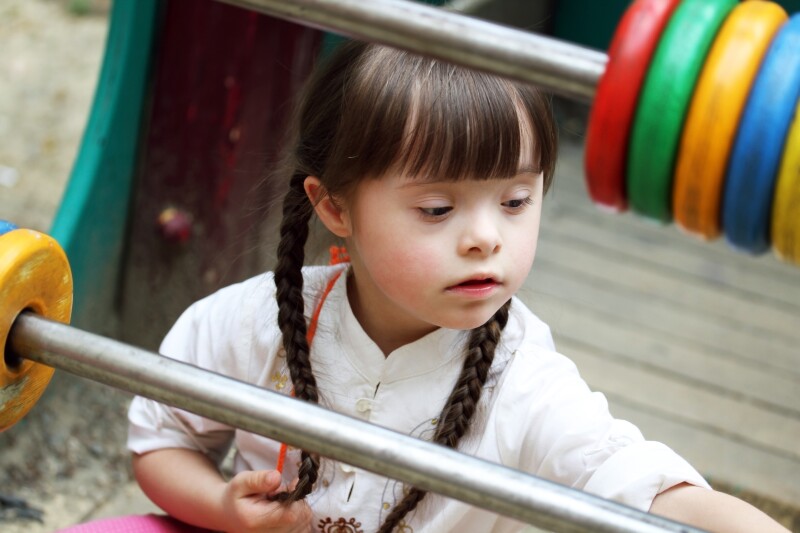When I study the scriptures, I often resonate with stories about how the Savior interacted with those with disabilities. As a mother of a child with Down syndrome and as a professional with a master’s of education in applied behavior analysis, there’s one story in particular that has always spoken to my heart:
“And as Jesus passed by, he saw a man which was blind from his birth. And his disciples asked him saying, Master, who did sin, this man, or his parents, that he was born blind? Jesus answered, neither hath this man sinned, nor his parents: but that the works of God should be made manifest in him” (John 9:1–3). Then Jesus knelt down, spat into the earth, and made clay. With that clay, he anointed the eyes of the blind man and instructed him to wash in the pool of Siloam. The man obeyed and returned seeing.
I think of the man’s parents who likely served and loved their child every day as the world around them offered misunderstanding and judgment. There were surely long days and tearful nights as they sought healing and refuge for their child. Their work and efforts prepared him for the world that he lived in and ultimately for the healing that came his way.
Parents of children with various disabilities face so much, and perhaps one of the heaviest burdens we carry is preparing our children to take their place in the world. But just like this man, our children have been placed here for a reason and for a purpose. They will have opportunities to show others the works of God. As parents, we can help prepare our children to thrive in their world, whether that be at school, church, or beyond. I would like to offer five simple tips you can use to help your children navigate their upcoming school year—and ultimately, the world around them.
- Prepare a “one-pager.” A one-pager is a printed one-sided sheet that has a picture of your child, their name, age, and some information about them. It’s great to include things they are good at and love to do, ways they like to relate to peers and teachers, and their favorite TV shows, snacks, games, and music. You could also include a brief explanation of their diagnosis, things they like to get help with, and how best to offer that help. You can then give this page to all the adults that work with your child as well as send it home to their classmates and their parents so they can see how their children are like your child. This often helps open the door for other children to talk about their similarities and build friendships with your child.
- Plan an effective communication method. One of the most important things a parent can do is to learn from their child’s teachers about the best way to communicate between school and home. Some teachers prefer emails, others have specific apps they use, and some may even prefer a notebook that stays with your child where you can write notes to the teacher and the teacher can respond to you. Once you establish how you will communicate, make sure you use it. Some information that may be helpful to tell the teacher is whether there have been changes to your child’s schedule—for instance, if they received less sleep than normal or ate less breakfast than usual. This might help a teacher better understand a child who struggles with communication. It is also important to discuss how frequently you will share information with one another. For example, you can decide whether to communicate on a daily, weekly, or on an as-needed basis. Remember that your child’s teacher is busy with many students and responsibilities, so try to be realistic in these expectations.
- Reflect school in the home. Children thrive with consistency. One way you can help your child is to try to do things that are done at school in your home. If your student’s teacher uses a sticker reward chart, ask if you can get a copy of a similar chart to use for other goals at home. Ask what songs they sing, books they read, and games they play in the classroom and try to do those same activities as a family. You can also learn what responsibilities your child has at school and try to mirror those responsibilities at home. One idea might be to teach your child to take their plate to the sink and wash their hands after meals if this is something they are expected to do in the lunchroom. The more similarities your child has between home and school, the more skills they will gain.
- Volunteer at school. As a working, single mom myself, I know that this can be difficult, but if you are able, be as present in the school and classroom as you can. Try to observe the other students around your child and see where natural friendships are developing. This could help you plan birthday parties and playdates with the friends your child has already made. Additionally, volunteering for the school shows that you are prepared to work with teachers and others as a team—they sacrifice so much for your child and your willingness to sacrifice for them in return goes a long way!
- Practice change and disappointment. Children with disabilities often find great comfort in routine and promises that are kept. When routines change or someone cannot follow through on a plan, it can be very frustrating for them. Things often change or do not go as planned at school, like an unexpected substitute teacher or poor weather canceling recess. One way parents can prepare children for such changes is to purposefully implement changes at home to help a child practice disappointment. For example, if your family goes to Grandma’s house every Sunday for dinner, perhaps one week you could cancel those plans and help your child overcome their disappointment by talking about their feelings, looking forward to the next time they go to Grandma’s house, and doing an activity together that is also exciting, like baking cookies. This may be a very difficult exercise at first, but it can help parents and children learn the skills needed to overcome ever-changing circumstances.
I believe that as we teach our children how to use their traits, skills, and voices, we will see the goodness of God manifested through them many times over. Sending our little ones out in the world can be scary and overwhelming, but through small efforts we will also see great miracles.
I think back to the man who was blind, who, through spending time with the Savior and having great faith in Him, not only received his sight but learned that he and his condition were not a mistake or curse but an opportunity to see the goodness and mercy of God in a real and tangible way.
Friends, keep going and keep teaching your children. Continue to prepare them for the world around them and watch in wonder as the Savior works in their lives to testify of His goodness and mighty miracles.
Everyday Disciples: Lessons Learned from Unnamed Scripture Heroes
Everyday Disciples testifies that every voice is needed, every testimony is important, and every soul is great in the sight of God.



